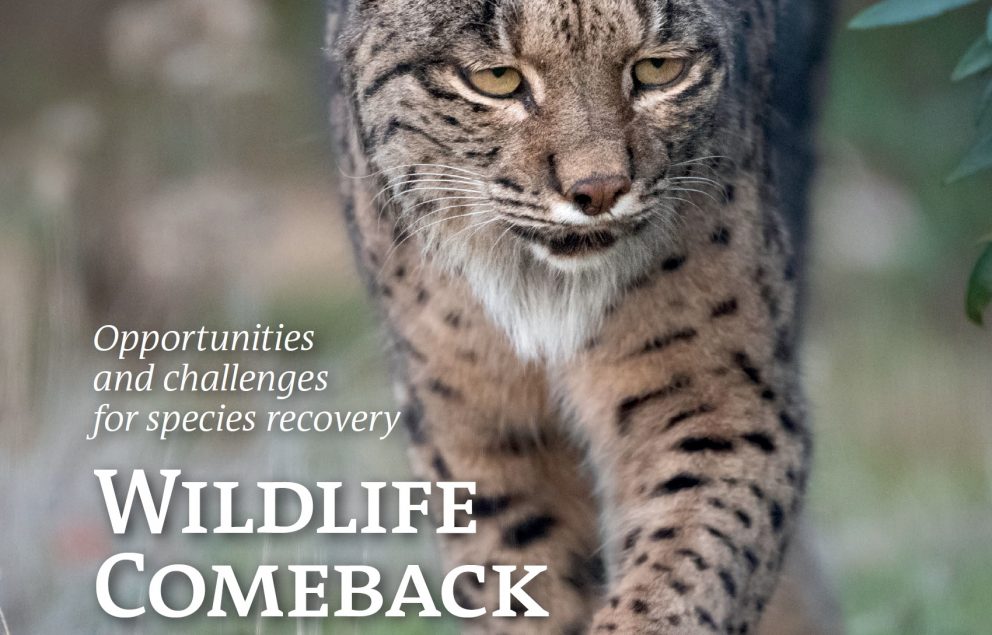
European wildlife comeback: a new report that shows how species return when we give them space to recover
October 24, 2022 | alena.klvanova
Commissioned by Rewilding Europe, it highlights species that have made a comeback in Europe over the last 40 to 50 years, explores the reasons behind their recovery, and provides an outlook for the future recovery of European wildlife. The Zoological Society of London, BirdLife International and the European Bird Census Council have compiled the information.
The report shows that the populations of some European wildlife species have grown – both in size and geographical range – over the last 40 to 50 years. The report looks at 50 European wildlife species, including a selection of 25 birds (Table 1), 24 mammals and one reptile. The EBBA2 project has had a prominent contribution to the project since it provided maps of current distribution and change of distribution between the 1980s and 2010s for all bird species. For some species and overall indicators, PECBMS was also very useful.
Among birds, 19 of the 25 species have expanded their ranges since the 1980s: These increases in distribution ranged from 7% for Osprey (Pandion haliaetus) to 585% for Barnacle Goose (Branta leucopsis) (Table 1). The population sizes of the 25 bird species covered in this report are estimated to have increased by an average of 470%, ranging from a 34% since 2002 in the case of the Black Stork (Ciconia nigra) to more than 5,000% since 1969 (Barnacle Goose). Reasons for upward population trends include legal protection through the EU Birds and Habitats Directives, policy and land use changes, species management, conservation efforts, and rewilding. For example, European populations of the Griffon Vulture (Gyps fulvus) are recovering mainly due to changes in legislation and intensive management and conservation. However, some species populations may be declining despite the previous recovery from historical lows, such as the White-headed Duck (Oxyura leucocephala), which is still affected by illegal hunting and habitat deterioration in some areas.
Table 1. Bird species included in the updated edition of the Wildlife Comeback and their change in distribution according to EBBA1 and EBBA2 data.
| Species | Change no. 50km sq. since EBBA1 | Species | Change no. 50km sq. since EBBA1 |
| Sterna dougallii | -39% | Ciconia nigra | 29% |
| Aegypius monachus | -26% | Grus grus | 33% |
| Falco naumanni | -25% | Aquila adalberti | 40% |
| Oxyura leucocephala | -20% | Pelecanus crispus | 67% |
| Falco cherrug | -18% | Larus audouinii | 67% |
| Aquila heliaca | -10% | Falco peregrinus | 88% |
| Pandion haliaetus | 7% | Cygnus Cygnus | 98% |
| Gyps fulvus | 14% | Himantopus himantopus | 103% |
| Ciconia ciconia | 21% | Platalea leucorodia | 165% |
| Gypaetus barbatus | 23% | Haliaeetus albicilla | 194% |
| Milvus milvus | 23% | Ardea alba | 419% |
| Botaurus stellaris | 24% | Branta leucopsis | 585% |
| Anser brachyrhynchus | 27% |
With wildlife species worldwide disappearing at an alarming rate, this new report brings encouraging news from Europe. It shows that wildlife will return if we give it space to recover and strive to live alongside it harmoniously. For birds, legal species protection (from shooting, egg collection, etc.), site protection, habitat management, and restoration are reported as the most important reasons for the observed cases of species recovery.
Finally, the Wildlife Comeback Report highlights the invaluable value of consistent monitoring, such as the work done by the EBCC and its network of partner organisations, which provides essential information about populations over time, without which this synthesis would not have been possible.
An online version of the Wildlife Comeback Report is available here: https://www.rewildingeurope.com/wp-content/uploads/publications/wildlife-comeback-in-europe-2022/.
Sergi Herrando
The Wildlife Comeback Report received financial support from Arcadia (a charitable fund), WWF Netherlands, and the Dutch Postcode Lottery.


